As you probably already noticed, I usually prefer to take a long-term view on various key markets and see what are the general tendencies are, so that I have better idea what might influence the precious metals sector and commodities in general. These sectors include USD Index, SPX, DJIA, other important international stock indices (also the emerging markets), CRB Index, Crude Oil, base metals, commodities' stocks and lease rates, and other important sector indices (financials, etc.). My previous essays were based on this type of analysis, but I usually focused on just a few elements not to bore readers with lengthy articles.
You are reading these words most likely because you want to know my views on the market in detail; therefore updates posted in this section will contain more detailed comments on the aforementioned markets / indices than what you used to read in other sections of this website and/or on other websites. I can't guarantee that I will cover each of them, because not every week there will be new developments on each of them worth commenting. I will try to focus only on those that influence your and my portfolio, which is generally precious-metals-oriented.
The USD Index
From the long-term point of view the U.S. Dollar has just completed or is in the process of completing the counter-trend bounce. It seems that more and more millions are printed each day to keep the system from falling apart. The powerful rallies that we have just witnessed are in my view caused by the irrational flight to safety. U.S. Dollar has long been considered "the safe currency" and many central banks, financial institutions and individual investors still perceive it as such, regardless of the true fundamental situation. At some point these entities will become aware of the fact that the assets that should be purchased with safety in mind are the precious metals, not paper dollars. However, at the time being, they either don't realize how bad the dollar's fundamentals are, or they act emotionally. Most likely both reasons are true, as there are many entities on the market. Either way, the reasons for a rising USD are temporary, just as the rebound is. I'm not saying here that we will not go higher temporarily - we may, although that seems unlikely - all I'm suggesting is that this is not the change in the main trend.
Of course there's always the inflation/deflation debate...
As far as the inflation/deflation debate is concerned, and its implications on the value of the U.S. Dollar, I find the inflationary path more probable at the moment. I base this assumption on the fact that right now The Powers That Be have chosen to print the problems away. It really means delaying these problems at the price of exacerbating them in the future - "but, hey - it will be years from now, so it's ok, right?" No, it's not "right" in our view, but fortunately we can prepare our portfolios for it - that's one of the reasons as to why we are in the precious metals market. Printing money means increasing the money supply, and increased supply of goods causes their price to fall. Currencies are no exception from this rule, though at times emotions might cause the opposite to be true in the short run.
If it is the buck that we are talking about, then it too has to ultimately depreciate, if its supply increases massively. The key question here is - against what will we measure its depreciation? We could use the Euro, Yen, and other important currencies, but that is only part of the story, as "currencies do not float, they sink at different rates". By that I mean that the relative value of two fiat currencies does not matter that much in terms of wealth preservation in the long term, because the real value of Euro, Yen, etc. can also drop in terms of real goods. We could have the same currency exchange rates next year (which I don't expect) that we have today, but how much would it matter if the price of virtually everything goes up many times?
Therefore, even if I am wrong in terms of the long-term direction of the USD trend (down), then we can still see (and profit from) much higher silver and gold prices. Some people believe that we are in a deflationary period and therefore gold (just like most tangibles) will go down in price, and that cash will be king. On the other hand, some argue that silver and gold are the ultimate form of cash and will therefore thrive. I have already covered this topic in one of the answers in the Editor Answers section. In short - I believe the fundamentals point to higher prices of precious metals in the long-run (we will get to the short run later in this report).
To make the most of the inflation/deflation debate, we must focus on the primary financial goal that I believe we share - to preserve capital (or even increase it) in case of a financial turmoil, and to make money even if that does not take place for years. In other words - you want to be well-positioned no matter which scenario turns out to be true. I will monitor the situation, but there are also things that we can do right away.
We take care of the second goal by dedicating part of our capital to speculation. This implies holding part of the capital in the form of cash. Although this should appeal to people who believe that the deflation is likely. We suggest putting a hefty share of one's long-term capital in the mining stocks (see the Key Principles section for details), to increase one's leverage in the sector and profit from the increased participation of new investors in this sector. This should appeal to people who (like your Editor) believe that inflation is likely, however there is much more to this sector than "just" the "inflation factor". The fundamentals of the precious metals market have been covered by many analysts, so I will not go into this topic again here. I wrote a brief summary of the gold market fundamentals, you might want to read it if you haven't done so already.
Having the first goal - capital preservation in mind, we keep a part of our holdings in the form of physical (!) bullion. I do not want the world financial system to crumble. I do not want the U.S. Dollar to be destroyed. Finally, I do not wish for people to lose their life's savings just because they 'forgot' to include precious metals in their portfolio. However, as an analyst, I consider all of the above as probable. It's not imminent, and not likely to happen today, tomorrow, or the next month, but with the current global economic and political environment, I believe that each investor should include precious metals into their portfolio. Even if you believe that deflation is likely, then perhaps it would still be a good idea to purchase physical metal, "just in case". You can treat it as insurance - most people buy their home insurance, even though they don't really think that their house is going to be destroyed in this way or another. They do it, because the consequences of that happening would be unbearable. You may purchase your physical bullion with the same attitude. Again, please refer to the Key Principles section for details.
Therefore, taking into account the previous two paragraphs, the inflation/deflation debate is really less important, than it would seem at the first glance. In fact, given the diversification between long-term investment, physical bullion, and speculative capital, the only thing that changes if one believes in the deflationary scenario is the weight between long-term investment and speculative capital. Should that be the case, one would most likely prefer to keep more capital in the form of cash while waiting for speculative transactions that are especially appealing from the risk/reward point of view.
As far as the short-term is concerned, please take a look at the below chart (charts are courtesy of stockcharts.com).
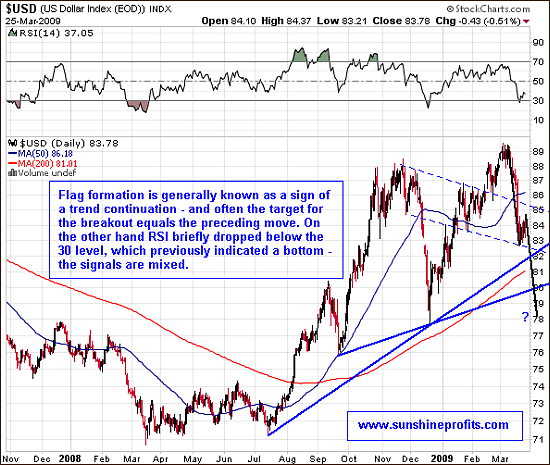
We have now a rather unclear situation on the dollar market. There are several support levels below the price (two support lines and the 200-day moving average) and it's difficult to tell which of these levels is most likely to stop the decline. We have now entered the flag formation which suggests that the drop will continue, however a brief rise to the 85 level would not surprise me either - especially given the signal from the RSI indicator. In sum - I believe that the breakout to the downside from the flag pattern is more probable.
However, I believe that the most important market to watch right now is...
The General Stock Market
From the long-term point of view, the general stock market has put an important bottom already, however it is not certain that this is the final bottom. With so much overall bearishness in the media it is probable that the worst (in terms of the DJIA) is behind us, however... That does not matter much from my point of view, as I don't have any long-term positions among the 'general stocks'. If we get higher, PM stocks are likely to multiply DJIA's gains, because of the favorable fundamentals.
On the other hand, if DJIA goes below the latest bottom and "all hell breaks loose", the precious metals stocks will still be among the strongest sectors. Please note what happened recently - PM stocks were hit hard along with other sectors, however their rebound is very sizable, especially if one compares it with the performance of the DJIA itself. Besides, precious metals market and the general stock market are often correlated in the short-run (sometimes positively, sometimes negatively), but in the long-term they move rather independently.
People often share emotions (fear, greed) and financial institutions are often required to cut positions on all markets at the same time, thus influencing prices of most assets simultaneously, however in the long run it is the fundamental situation of each market that determines, in which direction that particular market will go.
Moreover, since December PM stocks managed to rise along with falling stock market, the falling stock market does not necessarily imply similar declines on the PM market in the long term.
Yes, falling DJIA would put more pressure on the junior sector, however when we get to the third (PM-euphoria) stage of this bull market, I expect the junior sector to thrive regardless of the value of the DJIA. There is a positive correlation between the general stock market and the junior/senior miners ratio, but the third, parabolic phase of the bull market is characterized by enormous levels of emotionality on the market, and it seems that previously established correlations may not be useful anymore. Still, we are not yet at that point.
Moving on to the short term situation - the first thought that comes into mind after briefly looking at the below chart is that the decline has indeed been epic and that current bounce make the long-term picture bullish. However, the second look reveals that we have just broken out of the first important resistance line.
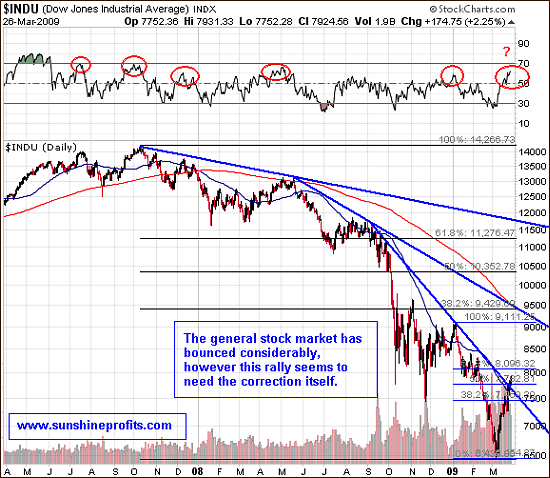
The almost 1500 point advance that took place in just three weeks is really something worth analyzing. There were a couple of times when Dow's performance has been similarly good, but it mostly resulted in another sharp decline - will this take place right now? It seems to be probable, given several signals that we currently see.
First of all we have just broken through the first of the multi-month resistance levels, and a test of this level is likely. The size/time of the rally itself is a warning sign. No market goes straight up or down (still, the final, parabolic stage of the current PM bull market will make this statement hard to believe), and since we have had an extraordinary upswing then at least a pause is to be expected. Finally, DJIA is getting close to the 61.8% Fibonacci retracement level of the previous decline. These levels often prove as a support/resistance, so it may be the case also this time. The RSI indicator has proven a fairly good indication of the local tops in the past, and it now suggests caution. We can't rule out the possibility that "this time it's different", but my own experience tells me that these are usually costly words.
Let's zoom in for more detailed view:
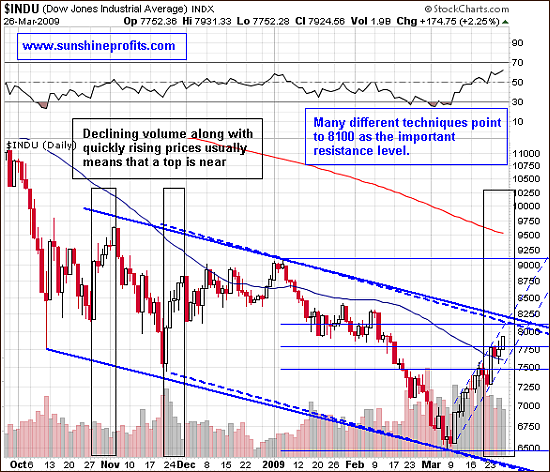
It is not only is the Fibonacci 61.8% retracement level that is suggesting some kind of pullback. The medium-term trend lines also indicate 8100 as the most probable resistance level. There is also one more key factor that needs to be considered here - the volume.
The declining volume along with rising prices is not a positive sign. It means that the buying power is drying up. This is definitely bearish information, because without fresh capital entering the market, prices cannot rise. When prices cannot rise, they will either trade sideways or slide. Since the size of the rally was impressive, the latter is more probable, as momentum traders realize their gains and make the price more vulnerable to a short-term sell-off. After such an impressive rally many investors wait for any signs of weakness to take profits off the table. If price gets to these important resistance levels and bounces just a little, it may cause these investors to get out of the market, thus intensifying the decline.
In the previous Speculative Alert, I suggested opening a speculative position in the PM stock sector. If the general stock market declines, it will most likely drag gold- and silver equities with it. Therefore, if the general stock market gets close to 8100 (above 8075) and no new factors will emerge, we will sell our call options. Options have time value, so it is usually most profitable to exit the trade earlier than it would be the case with stocks. Shorting the PM sector is not a good idea for this correction, as far as we are concerned.
The Gold and Silver Markets
There is not much to report today on the gold and silver markets, as far as timing is concerned. Gold once again is trading in the opposite direction to the USD Index, so everything that I wrote earlier regarding the USD Index can be applied here, keeping in mind the opposite direction.
In one the previous essays - Precious Metals Correct Sharply - But What If Dow's Slide is to End? I wrote:
(...) silver has formed one of the most bullish formations - cup with (small) handle. The longer the "cup" forms, the stronger the buy signal is. The above "cup" has been forming for about 5 months, which is quite long, at least for a short, to medium-term trading signal. Right now the "handle" is just being created. It's a tough call to say how low can it go temporarily, but $11-$12 is not out of the question.
It turned out that silver dropped just below the $12 level and bounced. This bounce is now being verified, and it seems that we will have more to report on in the following Premium Updates.
The recent breakout (which caused me to send out the latest Alert) has not been followed by a huge rally, so it seems that the key factor that contributed to the rise in the PM stocks was the positive influence of the general stock market. That topic has already been covered in this report
The Precious Metals Stocks
As mentioned earlier, the general stock market is approaching multiple resistance lines, which makes a pause or a decline probable. What is even more interesting is that the PM stocks have also a mix of resistance lines a few dollars above yesterday's closing price (taking GDX ETF as a proxy for the sector). Please take a look at the chart below:
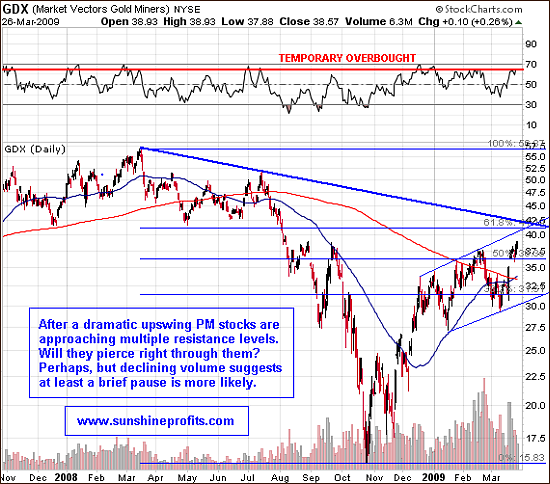
Although mining companies have particularly favorable fundamentals, the price patterns have been remarkably similar to those in the DJIA during the last few weeks. This time the 61.8% Fibonacci retracement level is calculated based on the whole 2008 decline, not only on the recent downswing, as it is the case with DIA. Still, implications are similar. The next resistance level that needs to be taken into account is the long-term resistance (thick) line and the short-term (thin) one. All of these levels point to the same area, which makes it even more likely to stop this upswing - at least for a while.
The price action on March 18th has been impressive, yet the gap that that followed may need to be filled, before price resumes its upward path. After this mini-rally it seemed that virtually all of my colleagues wrote an essay regarding the bullishness of that particular day. I sent an Alert myself right on March 18th. Naturally I respect the work of my colleagues, however my experience tells me that when everyone gets on the same side of the market, a correction of the preceding move is probable.
It is not out of the question that PM stocks will correct sharply only to soar in the following weeks, just as it took place in December 2008. However, for now it seems that we are approaching a local top.
The lowest resistance level marked on the chart above is just above $41, therefore it would be reasonable to place a sell order at or just below $41 - for example at $40.95. Combining it with the 8075 level in DJIA, creates the following suggestion regarding closing one's position: Sell if GDX gets above $40.95 or DJIA gets above 8075 - whichever happens earlier. Closing your positions earlier might be a good idea if you are more risk-averse.
Please note that we use options for our speculative trades, and this implies taking the time-value into account. If you use stocks instead, you may need to adjust our preferred trades accordingly.
In this report the table with speculative transactions is not really necessary, but will be included anyway, so that you know what to expect in the future Premium Updates. Although it may seem that drawing a few lines on a few charts is a very simple task, there is much more to the story than just that. The following table and instructions will provide you with additional information and will explain why we often use "weird" shares of positions sizes such as 17%, or 7% and why we often use a mix of different expiry dates.
The situation that we describe below is the current point of view on the April and June calls for the GDX ETF, strike 36. In the previous alert I did not provide you with exact shares for particular stocks (in order to send that alert ASAP), so I will use GDX as a proxy. The probabilities that I enter here are the probabilities for further gains above the aforementioned resistance level. "Gains" mean gains that would be achieved by GDX moving beyond that resistance level. Click on the image to enlarge it.
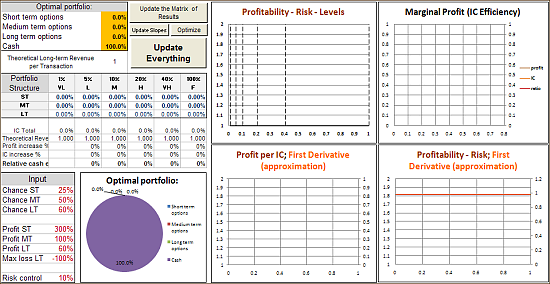
As you may see, for the entered probabilities the suggested position size for all risk-tolerance levels is 0.
As far as the non-speculative part of the portfolio is concerned - please refer to the Key Principles section for more details.
The last (but not the least) part of this Premium Update is dedicated to the junior sector. The tables below feature our favorite junior stocks at the moment of writing these words. For more information on how you can uses these lists please refer to the Key Principles section, especially to the part dedicated to juniors
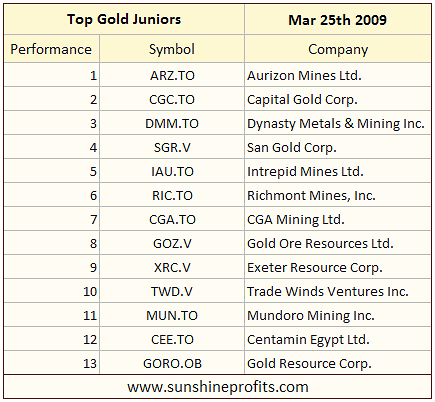
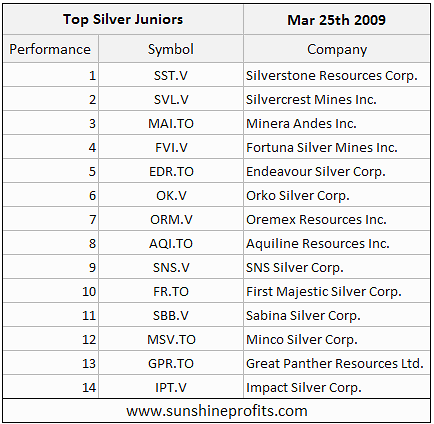
This is it for this week, thank you for reading. Again, the next update will be sent before the market opens next Monday (April 6th), but we will strive to post it earlier, possibly on Friday.
Have a great weekend and a profitable week.
Sincerely,
Przemyslaw Radomski


